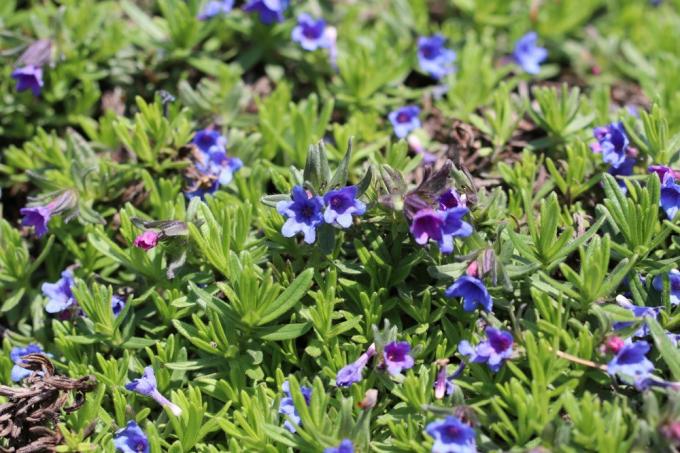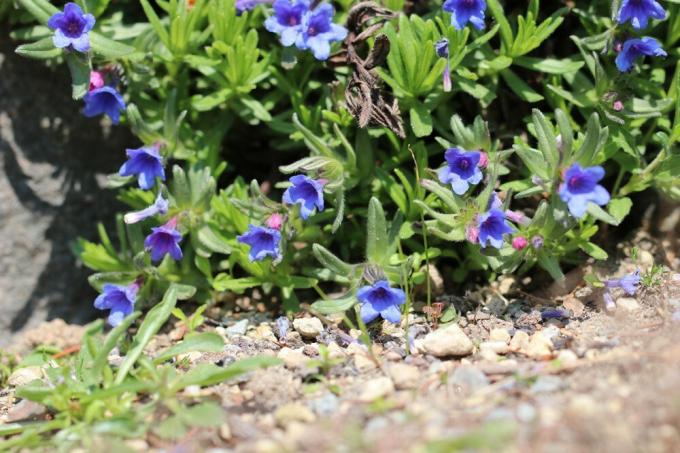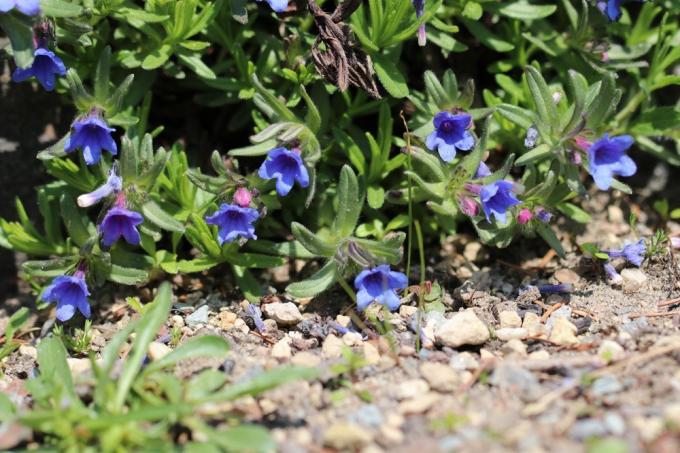
table of contents
- Characteristics
- Species and varieties
- Location
- floor
- plants
- care
- to water
- Fertilize
- Cut
- Overwinter
- Multiply
- Diseases and pests
Profile and care information open +conclude -
- Flower color
- White blue
- Location
- Partial shade, sunny, full sun
- Heyday
- April, May, June, July
- Growth habit
- perennial, clump-forming
- height
- up to 100 cm high
- Soil type
- sandy, loamy
- Soil moisture
- moderately dry, moderately moist, fresh
- PH value
- neutral, slightly acidic, acidic
- Limescale tolerance
- Calcium intolerant
- humus
- rich in humus
- Poisonous
- Yes
- Plant families
- Predator Family, Boraginaceae
- Plant species
- Evergreen ground cover, rock garden plants, container plants, border flowers, bedding plants
- Garden style
- Rock garden, natural garden, forest garden, gravel garden
Stone seeds are attractive plants from the Alpine region of southern Europe and are very popular with gardeners due to their modesty. The flowers in different colors add a splash of color in the garden, because the predatory leaf plant can be good for planting rock gardens and borders, as well as lush ground cover. The stone seed is an evergreen plant that is often offered as a perennial, although it is a dwarf wood.
Characteristics
- botanical name: Lithodora diffusa, formerly known as Lithospermum diffusum
- Genus: Lithodora (Lithodora)
- belongs to the plant family Boraginaceae
- Common names: Scheinsteiname
- compact dwarf shrub, bushy
- Height: 30-100 cm
- Leaves: finely hairy, rough leaves in green and lanceolate shape
- Blossom: simply double flowers in white or blue, funnel-shaped
- Flowering period: April to July
- Origin: Southern Europe, mainly Spain
- hardy
- not lime tolerant
- can go up to 60 cm in width
- Seeds slightly poisonous
- Ingredients: alkaloids
- evergreen
Species and varieties
Lithodora diffusa is one of the five species that belong to the genus Lithodora within the predatory family. The others are:
- Lithodora fruticosa
- Lithodora nitida
- L. oleifolia
- L. rosmarinifolia
All of these species have a similar morphology and only differ in a few points. The individual varieties of stone seeds are more interesting because they determine the different color variants of the plant. Stone seeds are typically presented in a bright blue, but the color can vary, which makes planting in your own garden even more interesting. The following are the varieties:
- 'Heavenly Blue': probably the typical variety with bright blue flowers
- 'Alba': variety with pure white flowers
- 'Snow': another variety with white flowers
- 'Star': this cultivar has a blue-white flower color that has resulted from mutation
- 'Grace Ward': blue to pinkish-purple flowers
- 'Cambridge Blue': an intense medium blue adorns these flowers
Tip: If you are interested in a Lithodora diffusa, you could run the risk of receiving a Lithodora oleifolia if you do not order from specialist retailers. Since these two species look extremely similar and require almost the same care, these taxa are often confused, which could lead to possible care errors.
Location

The location of the plant must be based on its natural range and be as follows:
- Light requirement: full sun to partial shade
- no direct midday sun
- Morning sun is preferred
- warm
- sheltered from the wind
Lithodora diffusa is very vigorous and likes to displace other plants. You should include this in your planning, as weaker plants are often displaced. You can prevent this with appropriate barriers. In addition, the location should be permanent, since Steiname does not tolerate relocating.
Tip: It is best to plant the stone seeds under translucent trees. These provide sufficient shade from the direct sun at lunchtime and the plant can bathe in the sun for the rest of the day.
floor
The soil for the plant is designed as follows:
- permeable
- humus
- moderately nutritious
- fresh
- not calcareous
- dry to moist
- pH value: 4.6 - 5.9
plants
You can plant rock seed specimens all year round, it is not sensitive. However, you should make sure that it is frost-free so that the plant does not have to freeze immediately. Proceed as follows:
- Plant spacing: 20 to 30 cm
- heavy soils are loosened beforehand with gravel, sharp sand, garden peat or humus
- then work in compost as a nutrient base
- now dig a planting hole
- meanwhile place the plant in a filled bucket of water
- the roots can thus prepare for planting
- insert the plant after digging the planting hole
- Fill up with soil, tread on it and water extensively
care

With the right location, the stone seed hardly needs any maintenance. Even watering and fertilizing becomes a small task. When overwintering, you don't have to do much either, which makes it a pleasant guest in the garden without a lot of problems.
to water
There is a rule of thumb for stone seeds: young or freshly planted Lithodora need more water, firmly grown specimens hardly need to be watered. If you have planted Lithodora diffusa in the garden, you have to water it more frequently in the first time and after that the plant can take care of itself. In particularly sunny locations, it is necessary to always keep the soil slightly moist. The more shade there is, the less water is needed. Note the following when pouring:
- water either early morning or evening
- not over lunchtime, as much of the valuable water will otherwise evaporate
- never let the soil dry out
- check regularly with the finger test whether the soil is damp
- never give hard water
- Use filter, rain or stale water
- a layer of mulch provides additional water storage
Fertilize
Lithodora diffus hardly needs any additional fertilizers, as it pulls most of it out of the soil. However, it is advisable to give the plant a long-term fertilizer such as horn shavings or compost in spring, which will provide it for the entire season. You simply lift this under the ground.
Cut
The Lithodora diffusa only needs a cut after winter, when dead plant parts have to be removed. You should not remove the withered flowers over the winter, as they provide additional winter protection. However, just cut them off in the spring. Every two to three years you should cut back the stone seeds compactly, because this stimulates the vitality and the development of new flowers and shoots. Otherwise you can leave the plant alone.
Overwinter
Rock seed plants can easily withstand temperatures down to -17 ° C and therefore do not need winter protection. However, if you live in a particularly cold region, you should cover the ground with brushwood to prevent the roots from cooling down. Make sure that Lithodora diffusa does not stand wet over the winter, as this leads to root rot, which can give the plant the rest. Do not be surprised, the predatory leaf plant can lose leaves and shoots can dry out over the winter, which is quite normal. You simply remove these in spring and then drive them out again.
Multiply

Stone seed plants are increased mainly by self-sowing. Because of this, you don't necessarily have to do this yourself. However, if you want to pull specific specimens, you can do this with cuttings. The period from May to June is best:
- cut off cuttings with disinfected, sharp secateurs
- shoots from the current year that are not completely lignified are used for this
- The cut is always made above a leaf knot
- About three pairs of leaves should be present on the cuttings
- be careful not to crush the cuttings
- soak the cuttings in willow water for 24 hours
- alternatively, a root hormone is recommended, in which the lower part of the cutting is only dipped for a few minutes
- Wash cuttings with clear, lime-free water
- then plant in pots with potting soil
- cover with cling film
- Germination time: up to two weeks
- Prick out from the first shoot
- You can plant the young plants either in pots or directly protected in the field
Alternatively, you can easily propagate the plant using lowering devices:
- choose an adult specimen
- bend one of the side shoots down to the ground
- fix it with a stone or wire
- now you have to wait a few weeks for roots to form on the sinker
- relocation of the new plant is not necessary
A division is also available. To do this, take a specimen out of the ground in either frost-free autumn or spring and divide it with a sharp, clean spade. Then put the pieces back into the ground. Observe the planting distance of up to 30 centimeters and then moisten the soil so that the sections can develop fresh roots.
Diseases and pests
Lithora diffusa hardly suffers from pests and diseases, but has to struggle with snails that feast on the delicious parts of the plant, especially the young leaves. Already lignified shoots are not eaten. Since snails like to build their nests right under the plant, you need to protect the stone seeds with either slug pellets or sawdust that is spread around the plant. Other problems arise from incorrect maintenance, especially in winter when the soil is too wet.
